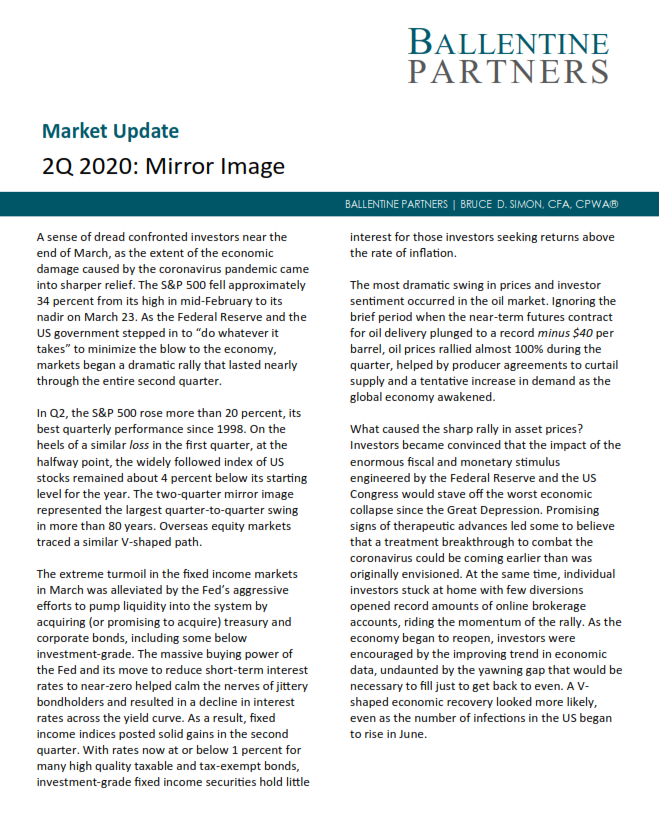Market Update
A sense of dread confronted investors near the end of March, as the extent of the economic damage caused by the coronavirus pandemic came into sharper relief. The S&P 500 fell approximately 34 percent from its high in mid-February to its nadir on March 23. As the Federal Reserve and the US government stepped in to “do whatever it takes” to minimize the blow to the economy, markets began a dramatic rally that lasted nearly through the entire second quarter.
In Q2, the S&P 500 rose more than 20 percent, its best quarterly performance since 1998. On the heels of a similar loss in the first quarter, at the halfway point, the widely followed index of US stocks remained about 4 percent below its starting level for the year. The two-quarter mirror image represented the largest quarter-to-quarter swing in more than 80 years. Overseas equity markets traced a similar V-shaped path.
The extreme turmoil in the fixed income markets in March was alleviated by the Fed’s aggressive efforts to pump liquidity into the system by acquiring (or promising to acquire) treasury and corporate bonds, including some below investment-grade. The massive buying power of the Fed and its move to reduce short-term interest rates to near-zero helped calm the nerves of jittery bondholders and resulted in a decline in interest rates across the yield curve. As a result, fixed income indices posted solid gains in the second quarter. With rates now at or below 1 percent for many high quality taxable and tax-exempt bonds, investment-grade fixed income securities hold little interest for those investors seeking returns above the rate of inflation.
The most dramatic swing in prices and investor sentiment occurred in the oil market. Ignoring the brief period when the near-term futures contract for oil delivery plunged to a record minus $40 per barrel, oil prices rallied almost 100% during the quarter, helped by producer agreements to curtail supply and a tentative increase in demand as the global economy awakened.
What caused the sharp rally in asset prices? Investors became convinced that the impact of the enormous fiscal and monetary stimulus engineered by the Federal Reserve and the US Congress would stave off the worst economic collapse since the Great Depression. Promising signs of therapeutic advances led some to believe that a treatment breakthrough to combat the coronavirus could be coming earlier than was originally envisioned. At the same time, individual investors stuck at home with few diversions opened record amounts of online brokerage accounts, riding the momentum of the rally. As the economy began to reopen, investors were encouraged by the improving trend in economic data, undaunted by the yawning gap that would be necessary to fill just to get back to even. A V-shaped economic recovery looked more likely, even as the number of infections in the US began to rise in June.
Outlook and Strategy
As we enter the third quarter, the near-term outlook for financial assets remains exceptionally uncertain. For the stock market to continue its surprising recovery from the March lows, several important issues will need to be favorably resolved in the next few months. These include:
- The consequences of reopening the economy on virus transmission – As the number of new infections accelerates, consumers’ willingness to return to normal shopping and spending behaviors will be critical to sustaining the economic rebound. Government policies to reopen the economy will be less important to the recovery than people’s fears over contracting the virus, and recent surveys confirm a strong inverse correlation between infection rates and Americans’ comfort with resuming normal activities. Nonetheless, we do not believe another full-scale lockdown is likely.
- Uncertainty surrounding the size and scope of the next stimulus package – While economists and politicians seem to agree that another stimulus package will be necessary after many of the current benefits expire on July 31, there remains a wide divergence in opinions about how much is necessary and where it should be targeted. The surprisingly strong May jobs report could make conservatives more reluctant to agree to another large package, although the surge in new infections may encourage lawmakers to be more generous.
- Rapid increase in infections in less-developed countries – Along with the rapid expansion of new cases in certain US states, growth is exploding in densely-populated emerging market countries such as Brazil, Mexico, and India, whose health systems are less equipped to handle a spike in cases. Emerging market countries have shown a greater willingness to impose stricter lockdown policies than the US, with a corresponding impact on economic activity.
- Results of clinical trials starting to come in – Several therapeutic remedies are entering large-scale Phase III trials, and results are likely to be released over the next few months. As investors are counting on a near-term therapeutic breakthrough, disappointing results could result in a significant market setback.
- High valuations – The sharp rally in global stocks has lifted valuations to extreme levels. According to Yardeni Research, the S&P 500 was trading at approximately 21 times forward 12-month earnings on June 26th, the highest since the early 2000’s dot-com bubble. Global valuations have also increased, but to a lesser extent. Corporate earnings over the next 12 months will need to approximate pre-COVID levels in order to justify these valuations.
We do not dismiss the possibility of a continuation of the upward surge in equity prices. A recent shift in leadership in the stock market (favoring the laggards over the former leaders) is consistent with a strengthening bull market. The US dollar has fallen, indicating more global investors are willing to venture away from the supposed safe haven of the US economy. The scientific firepower being applied to the search for a vaccine may result in a significant breakthrough, allowing the global economy to rapidly recover to its pre-pandemic state. And another round of fiscal stimulus may provide enough support to the weakest parts of the economy to avoid serious long-term damage. In any case, we believe the likelihood of a severe setback in equity prices (down 25 percent or more from current levels) is unlikely, given the extraordinary economic support provided by the US government and the strong desire for people to get the economy moving again.
The next few months will provide important insights and will resolve the question of whether the market’s spectacular spring rally was accurately forecasting a strong V-shaped recovery or was a misguided hope of an early return to normalcy. In either case, the long-term outlook for equities remains strong.
About Bruce D. Simon, CFA, CPWA®
Bruce is a Partner and the Director of Research at the firm. In addition to working directly with a number of family clients, Bruce serves on Ballentine’s Investment Management Committee, which is responsible for the oversight of all of the investment activities for the firm.
This report is the confidential work product of Ballentine Partners. Unauthorized distribution of this material is strictly prohibited. The information in this report is deemed to be reliable but has not been independently verified. Some of the conclusions in this report are intended to be generalizations. The specific circumstances of an individual’s situation may require advice that is different from that reflected in this report. Furthermore, the advice reflected in this report is based on our opinion, and our opinion may change as new information becomes available. Nothing in this presentation should be construed as an offer to sell or a solicitation of an offer to buy any securities. You should read the prospectus or offering memo before making any investment. You are solely responsible for any decision to invest in a private offering. The investment recommendations contained in this document may not prove to be profitable, and the actual performance of any investment may not be as favorable as the expectations that are expressed in this document. There is no guarantee that the past performance of any investment will continue in the future.




